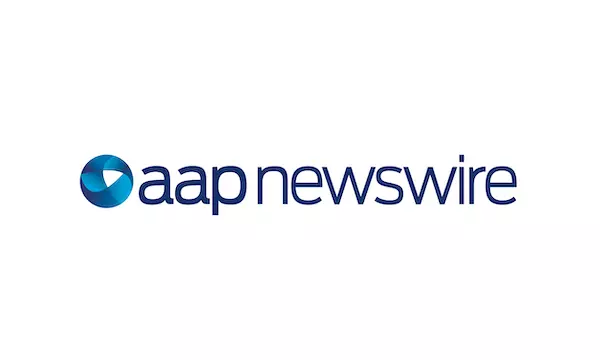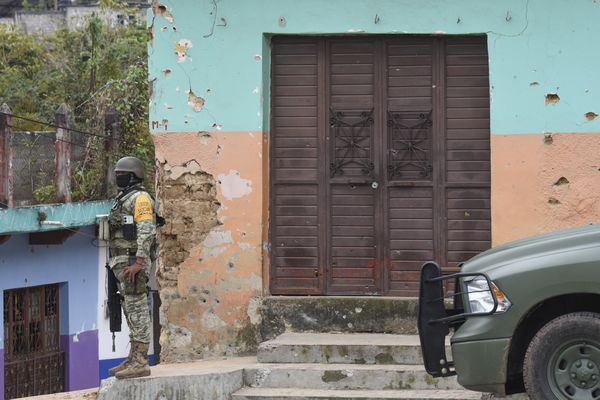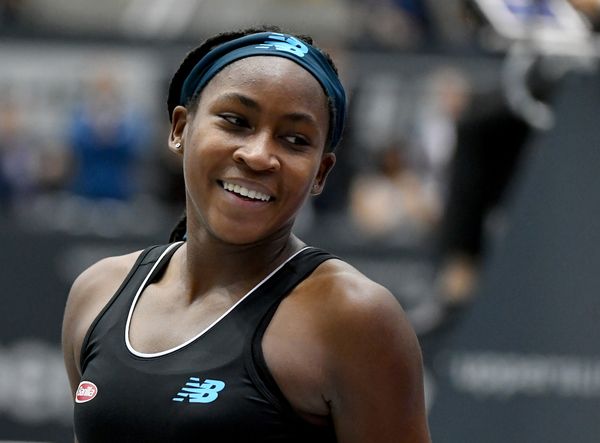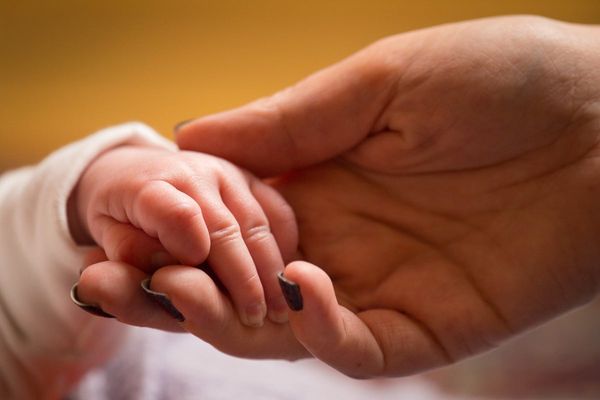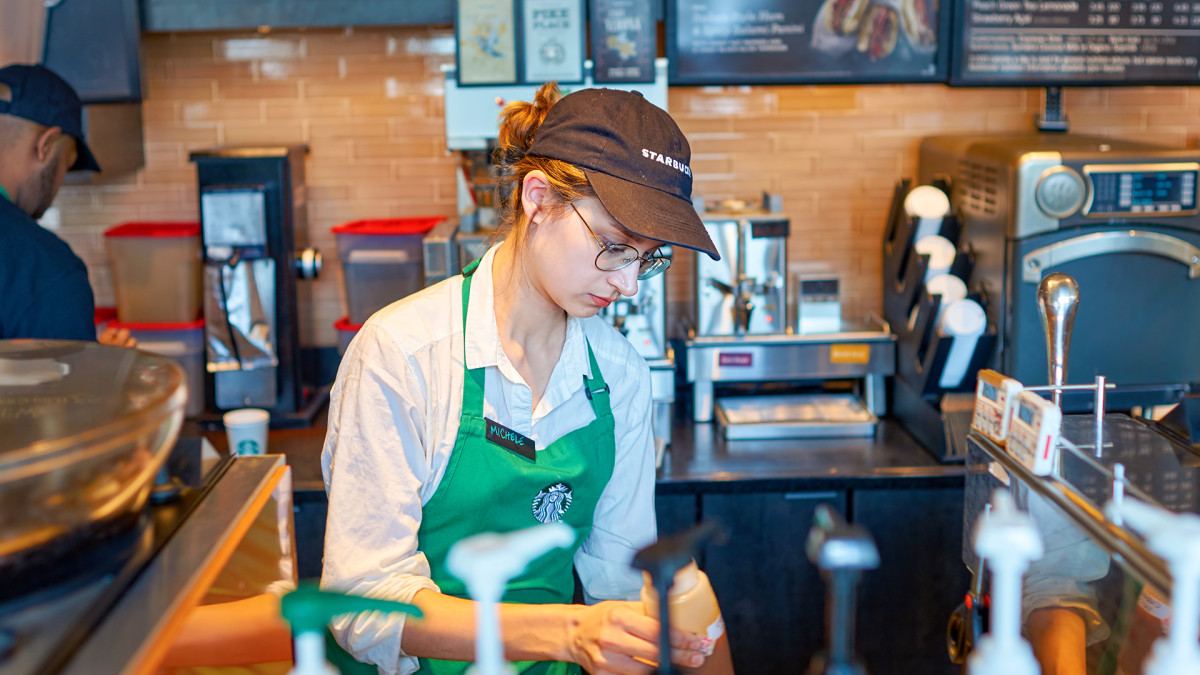
Starbucks (SBUX) -), the world’s most recognizable coffee brand, operates over 16,000 dine-in and drive-through cafes in the U.S., with more than 19,000 additional locations scattered across the rest of the world. Most of these offer sandwiches, pastries, coffee beans, and coffee accessories on top of the impressive array of coffee-related beverages the brand is best known for, which range from the traditional (like drip coffee, lattes, and cappuccinos) to the elaborate (olive-oil-infused espresso drinks, apple crisp oatmilk frappucinos, and the fall-favorite pumpkin spice latte, to name a few).
Happy 20th bday, PSL! 🧡 To celebrate the drink that makes us feel as warm and fuzzy as a velour tracksuit, let’s go back to the year it all began: 2003. pic.twitter.com/fZcBuQWdAb
— Starbucks (@Starbucks) October 10, 2023
But the quintessential caffeine purveyor wasn’t always so barista-centric. When the first Starbucks opened its doors in Seattle in 1971, it simply sold gourmet roasted Peets coffee beans (a company it would later purchase) and coffee-making equipment like grinders, french presses, and pour-over kits. Starbucks started selling brewed beverages in the early 80s, shortly before Howard Schultz, the company’s famed three-time former CEO, joined the team. By 1992, the company had gone public and was operating over 150 stores in the U.S., and a decade later, almost 6,000 Starbucks locations were open worldwide.
Now with over 35,000 cafes across the globe, Starbucks has become an incredibly prolific employer, boasting a workforce of more than 400,000 employees as of 2022. To job-seekers, Starbucks is known for its competitive pay, upward mobility, generous benefits, and employee stock options, so it’s no wonder the coffee giant has grown into one of America’s most popular places to work.
Are you considering donning the brand’s iconic, mermaid-clad green apron and seeing if you have what it takes to pull espresso shots fast enough to meet the caffeine needs of Starbucks’ daily stampede of bleary-eyed commuters? Here’s what you need to know about the company’s positions, pay, perks, and pitfalls.
Related: Amazon delivery driver salary: How much they really make
How much do Starbucks baristas make hourly?
As of late 2023, all available Starbucks barista jobs listed on the company’s website started at $15 per hour or more (the company raised its internal minimum wage to $15 in 2022), with jobs in areas with higher costs of living offering higher starting pay. For instance, one barista position in Circle Pines, MN, listed a starting pay range of $15.50 to $17.60, while another position in New York, NY, offered a starting range of $17.50 to $19.87.
As with most service positions, where an applicant lands in the starting pay range usually depends on whether they have previous experience — in the case of Starbucks, prior cafe work is king, but any customer-facing experience in food service or cashier operation could provide a leg up.
Like most other employers, Starbucks increases worker compensation over time based on experience and performance, so $15 per hour is just a jumping-off point. According to Indeed, a leading career data site, self-reported Starbucks barista wages can go up to $24 per hour, although the real wage cap could be higher, as self-reported wage data on sites like Indeed is limited and may be out of date.
How much do shift supervisors make?
According to Indeed, shift supervisors at Starbucks earn an average of $19.22 per hour with $31.40 being the high end of the pay range. Glassdoor puts the average at $19 with the high end of the range at $21.
How much do managers make?
Starbucks store managers, according to Indeed, earn an average salary of around $66,000 annually but can make up to $105,000. Glassdoor also puts the average at $66k but caps the high end at $80k.

Do Starbucks baristas get tips? Everything you need to know
Until 2022, most Starbucks stores did not accept digital tips — customers could only tip in cash or via the Starbucks app. This severely limited the tip income baristas could make, as most customers pay for their everyday purchases with credit or debit cards, and only the most devoted Starbucks customers tend to use the brand’s app.
Since 2022, most Starbucks locations have allowed digital tips on credit and debit card purchases, so customers who don’t carry cash or use the brand’s app can now tip easily as they would at other cafes.
Interestingly, digital tipping was withheld from unionized stores in a widely criticized move by management that many interpreted as retaliatory. A complaint levied by the National Labor Relations Board (NLRB) alleges that this violates federal labor laws.
According to a barista working in Portland, OR, in late 2023, cash tips (which have reportedly gone down since the digital tipping option was implemented) are distributed evenly to all baristas according to hours worked. Digital tips are also allocated based on hours worked but are paid out as part of baristas’ paychecks at the end of each two-week pay period. Digital tips and tips from the Starbucks app are each listed separately from base pay on baristas’ paystubs.
According to this same source, tip income in general seems to have gone up since digital tipping was introduced, with digital tips exceeding cash and app tips by a significant margin. In November 2022, a Starbucks barista on Reddit posted “Digital tips literally quadrupled my weekly tips. BOUT D*MN TIME.”
As for how much any given barista can expect to make in tip income, there is no meaningful average available, as tipping trends vary geographically and are based on individual store traffic. Highly trafficked stores in dense, urban areas tend to receive more customer tips than more obscure locations with fewer total daily customers.
According to various reports from baristas on Indeed and Reddit between 2016 and 2020, tips can range from $0.25 per barista per hour to over $4, and tips tend to go up significantly around the winter holidays. Anecdotal reports also suggest that repeat customers tip well, especially when their baristas go out of their way to connect with them on a personal level.
What employee benefits does Starbucks offer?
Starbucks’ reputation for a robust benefits package is longstanding, and both full and part-time employees are eligible. For full-time employees, benefits typically begin on the first day of a new month following 60 days of employment. For part-timers (who must work 20+ hours per week to be eligible), eligibility begins after 240 hours have been worked over a three-month period.
Here’s a closer look at what Starbucks workers can expect from their benefits package.
Educational benefits
In terms of higher education, the coffee chain’s offering is perhaps second only to the U.S. military’s GI Bill. The Starbucks College Achievement Plan program allows eligible full and part-time employees to attend Arizona State University online and earn one of more than 140 available bachelor program degrees for free. Books and supplies aren’t covered, but between the Starbucks tuition benefit and a supplementary scholarship offered by ASU specifically to Starbucks employees, employees end up paying $0 in tuition.
Only those who have not already received a bachelor’s degree elsewhere are eligible, but other than that, any Starbucks (or subsidiary) employee in the U.S. can apply for the program. Once enrolled, students must remain in “good academic standing” (a GPA of 2.0 or higher) in order to retain their ongoing eligibility.
Healthcare
In terms of healthcare benefits, Starbucks offers sponsored medical, dental, and vision plans at various costs and coverage levels so each employee can choose the plan that best fits their needs. Employees may also choose to contribute to tax-advantaged health and dependant care reimbursement accounts. Sponsored life, disability, and accident coverage insurance plans are also available.
Retirement and stock
Starbucks’ “Future Roast” 401(k) retirement plan allows employees who have worked 90 or more shifts to contribute anywhere from 1% to 75% of their paycheck to a traditional (pre-tax) or Roth (post-tax) 401(k) account. Starbucks offers a 5% match, meaning it matches employee 401(k) contributions of up to 5% of their paycheck — a fairly high matching percentage usually only seen in white-collar positions.
Starbucks employees can also purchase the company’s stock at a 5% discount using 1–10% of their base pay each quarter via the company’s Stock Investment Plan (S.I.P.). In 2023, the company began allowing fractional stock purchases through its S.I.P., meaning employees no longer have to purchase discounted stock in whole shares.
PTO, holidays, sick time, and leave
Starbucks recognizes seven paid holidays each year, and employees who work on these holidays are paid 1.5 times their normal wage. Sick time is accrued at a rate of 1 hour for every 25 hours worked.
Employees also begin to accumulate paid vacation days after 12 months of service with the company. The longer an employee stays with the company, the more vacation days they become entitled to per year.
Employees are paid their normal wages if they must be excused to complete jury duty. All employees are entitled to two to four days of bereavement leave depending on travel specifications, and leaves of absence for other reasons may also be approved depending on the circumstances.
What other perks do Starbucks employees get?
In addition to the suite of benefits listed above, Starbucks also offers its workers a variety of attractive perks:
- 1 free bag of coffee or box of tea per week
- Unlimited free drinks during shifts
- 7 free food items per week
- 30% discount at all Starbucks locations
- Free Spotify Premium subscription
- Free Headspace subscription
- 20 free therapy sessions per year via Lyra
- “Perks at Work” portal with discounts at a variety of retailers
What are the downsides to working for Starbucks?
Despite its decent pay and impressive array of employee benefits, Starbucks jobs do come with some potential downsides.
One of the most common difficulties baristas face is the difficulty of learning how to make the many different drinks on the Starbucks menu. Between the core beverages offered by all locations at all times, the chain’s rotating seasonal offerings, and the not-so-secret “secret menu,” it can take quite a while to become acclimated as a newer barista. On top of this, customers often modify or customize their drinks, which can make things even more complicated. According to one former employee, it can take around six months to become totally comfortable with the chain’s menu and drink-crafting conventions.
The job can also be difficult for those who are introverted and may be easily overwhelmed during hectic situations. Most Starbucks locations experience multiple daily “rushes” during which a sudden and sustained surge of customers requires all hands on deck working double time to craft drinks accurately and efficiently while remaining friendly and helpful to sometimes impatient customers.
Shift hours can also be challenging for some. Opening shifts can start as early as 5 a.m., and closing shifts, which vary depending on how late a location stays open, involve deep cleaning the store in preparation for the next day’s opening.
Overall, however, as far as low-barrier-to-entry jobs go, barista positions at Starbucks seem to outshine similar jobs in terms of pay, perks, and nationwide availability.
